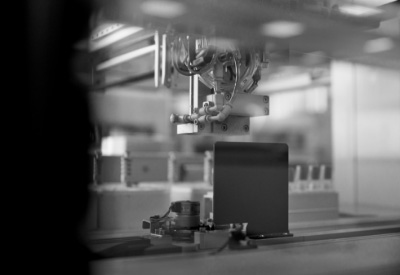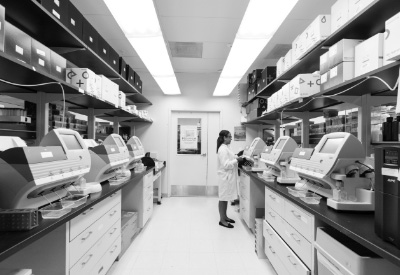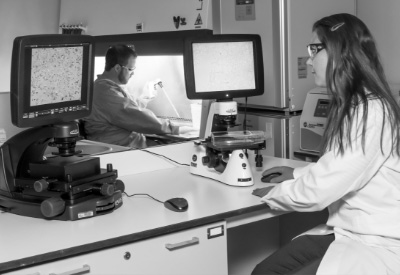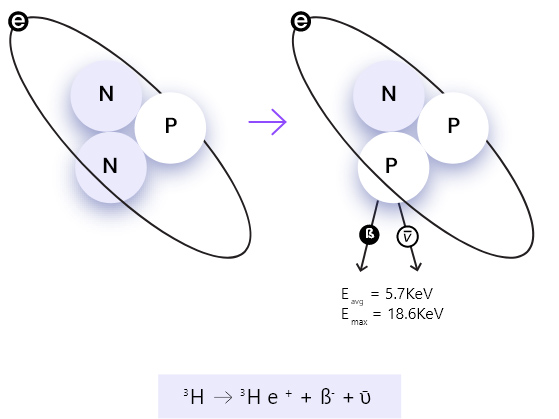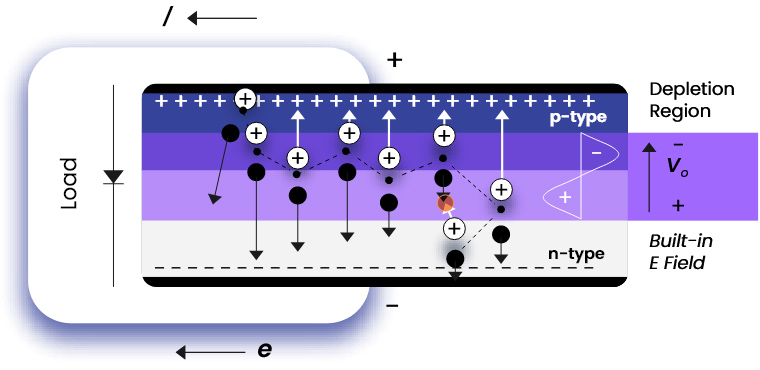
NanoTritium™ Battery Technology for Microelectronics
City Labs, Inc. is the pioneering innovator of long-life (20+ years) NanoTritium™ batteries for microelectronics. The battery is resistant to varying temperatures and other environmental conditions due to the robustness of the tritium decay process.
As confirmed in independent testing by Lockheed Martin, the City Labs P100 Series NanoTritium™ battery is resistant to extreme temperature variance (-55°C to +150°C). The battery can also endure extreme vibration and altitude due to the robust architecture of City Labs’ proprietary technology and the properties of tritium.
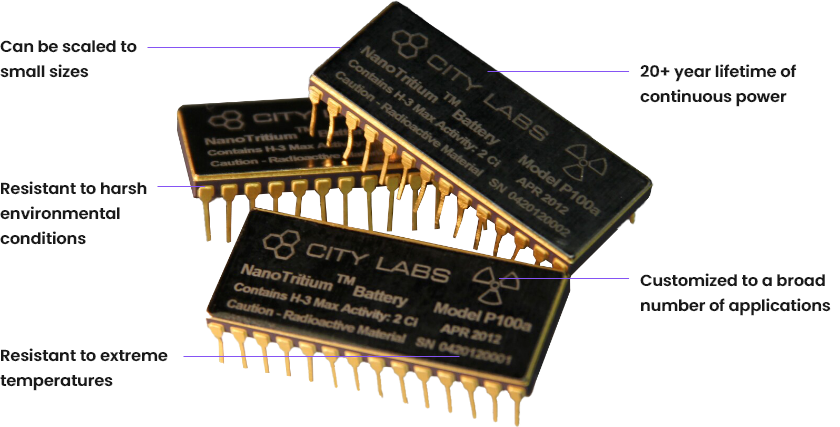
What is Tritium?
Tritium is a beta- (electron) emitting byproduct of certain nuclear power plants (e.g., CANDU Reactors), which City Labs implements in a safe and effective power-harvesting battery. Tritium is the most benign radioactive isotope and is already used as an illumination source for exit signs commonly found in schools, theaters, commercial buildings, and commercial aircraft.
Tritium has a half life of 12.32 years, meaning only half of the battery’s fuel will be used after more than a decade. The tritium battery will continue emitting low powered electrons independently of temperature or any environmental conditions. This is very different from conventional batteries that are dependent on chemical reactions to produce electrons to provide power.
20+ Year Lifetime
Even if a conventional battery had enough chemical fuel to last 20 years, the chemical reactions in the battery are extremely sensitive to impurities, leaks, corrosion, temperature variations, and other environmental factors. These weaknesses generate a host of battery life reliability issues that cause conventional batteries to fail over long periods of time.
As betavoltaic-based batteries rely on radioactive decay, which occurs independently of temperature and other environmental factors, they can run for far longer periods of time than traditional batteries. Early NanoTritium™ batteries developed at City Labs over 15 years ago are still operating efficiently. Simulations suggest they will continue to function for over 20 years. This unmatched functionality and reliability make NanoTritium™ batteries ideal for providing long-term power solutions.
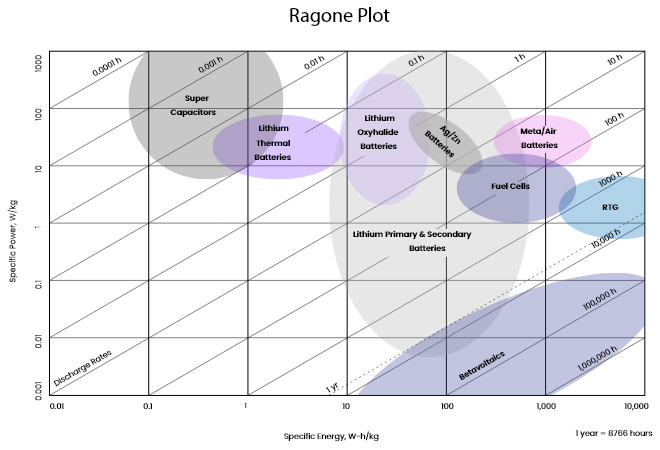
One Amazing Battery
Betavoltaics are a type of nuclear battery that do not rely on temperature differences between nodes to generate a charge. Our tritium betavoltaic battery converts the incident energy of decaying beta particles into electricity.
Radioactive decay is a natural process that does not require artificial chemical reactions. In extreme hot and cold conditions, tritium will continue to emit beta particles. This means that throughout the entirety of its lifespan, our battery will generate electricity at a steady, slowly decreasing rate. This predictability of power output enables those in charge of battery maintenance to more accurately plan for when devices may need to be replaced or serviced.
Types of NanoTritium™ Battery Technology
Microwatt Batteries
Microwatt batteries are power cells that output a charge typically measured in microwatts. They can supply a variety of charges based on their power. Low-power models output single-digit microwatts, and high-power models can supply burst charges in the milliwatt range. Microwatt batteries often power smaller devices due to their small and compact structure.
Nanowatt Batteries
Nanowatt batteries supply electricity within the nanowatt range and can power a variety of devices. City Labs has developed betavoltaic tritium batteries to power devices in the nano-microwatt range with milliwatt burst capabilities. Nanowatt batteries feature a variety of benefits including long-term power sources and increased sustainability.
Additional Benefits
Our NanoTritium™ technology offers more than reliable long-term power; there are a variety of other benefits to investing in our products. For example, along with temperature resistance, City Labs’ betavoltaic batteries can endure higher radiation levels than electrochemical cells. Radiation-tolerant components are necessary for some spacecraft or nuclear power plant devices.
Tritium is also a sustainable power source. Our batteries are made from nuclear waste materials and decay to a stable state. Once the tritium has reached the end of its 20+ year lifespan, its radioactivity will be neutralized.

Encryption Security
NanoTritium™ batteries are used to keep encryption keys alive in static random access memory (SRAM) for more than 20 years in digital processors, such as field-programmable gate arrays (FPGAs). These keys are maintained in SRAM volatile memory while the FPGA or processor is powered down. The NanoTritium™ battery maintains power to the SRAM even in harsh temperature environments. This is a benefit over conventional batteries that are chemical based (e.g., lithium, NiCad, etc.)

Customizable Package Specifications
Our P100 Series battery can be ordered in multiple different pre-designed configurations. Using one of our existing designs will increase the speed and ease of integration. By offering a choice, we hope to accommodate most partners without the need for serious modifications. If your device is unique, we may be able to customize the battery package to match your needs. Reach out to see if our engineering team can build what you’re looking for. However, understand that customized batteries will take much longer to design and manufacture, which is why, if it’s possible, we highly recommend incorporating one of our existing packages.

Third Party Testing
Lockheed Martin Missiles and Fire Control conducted an industry survey of tritium batteries, the results of which were presented at the 2008 Anti-Tamper Conference. Lockheed Martin’s independent third-party survey demonstrated that City Labs’ rugged NanoTritium™ betavoltaic battery outperformed its competitors with the best combination of power and energy density. And additional third-party testing demonstrated an extended temperature range: -55°C to +150°C.
FAQs
Does City Labs offer more than one betavoltaic battery?
Currently, the only available City Labs product is the P100 Series NanoTritium™ Battery. The P100 is available in multiple packages but maintains the same power output across designs.
We are in the process of manufacturing the P200 Series NanoTritium™ Battery for commercial use. The P200 will further expand upon tritium technology to produce a larger output that can be used for higher power devices.
Additionally, these next generation batteries will be capable of milliwatt power bursts lasting several minutes through the incorporation of secondary (i.e., rechargeable) thin-film batteries and/or capacitor-like devices.
How is tritium processed?
City Labs’ tritium is processed in a tritium manifold that allows us to perform work beyond just batteries. We perform work like experimenting with metal tritides for fusion research organizations and radar systems.
The only other labs with comparable capabilities are the Savannah River National Laboratory and Lawrence Livermore National Laboratory, neither of which are private organizations. If you’re looking to utilize tritium power sources for microelectronic devices, City Labs is your best option.
What is the CHIPS Act?
The microelectronics industry has received a large economic boost from the passing of the CHIPS and Science Act of 2022. “CHIPS” stands for “Creating Helpful Incentives to Produce Semiconductors.” This comprehensive legislation allocates almost $53 billion for semiconductor development in the U.S.
The CHIPS Act has set a variety of actions into motion. On top of establishing microelectronics-centered government committees, there is also a wide range of funding options available for new and existing companies. Businesses that aid in the research and/or development of semiconductors or semiconductor components will be eligible for grants and tax credits.
This initiative was designed to reclaim semiconductor manufacturing operations in the U.S. and reduce dependence on international trade.

How City Labs’ Nanobattery Technology Is Shaping the Future
The possibilities of nuclear power vastly outnumber the current capabilities of electrochemical batteries. Harnessing radioactive decay to generate electricity creates a more consistent and resistant flow of energy. Nickel-cadmium and lithium-ion batteries are limited by their environment and the nature of their internal chemical reactions. Tritium batteries are in the early stages of development and already surpass traditional models in both longevity and durability.
City Labs is researching the next step to increase our power output for higher power devices. If you are interested in working with us to advance betavoltaic power cells or could use our existing product, fill out the contact form on our website to schedule a meeting with our CEO.
The Nuclear Battery Company With a Vision
Ready to power your next innovation or learn more about our technology?
Contact Us Today
